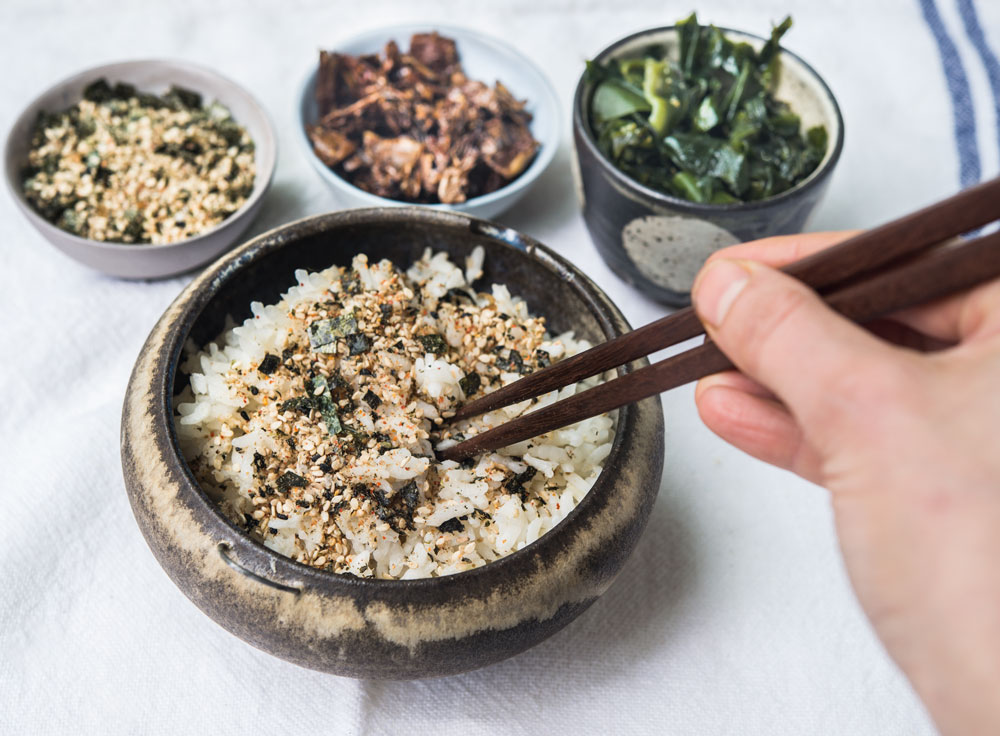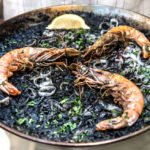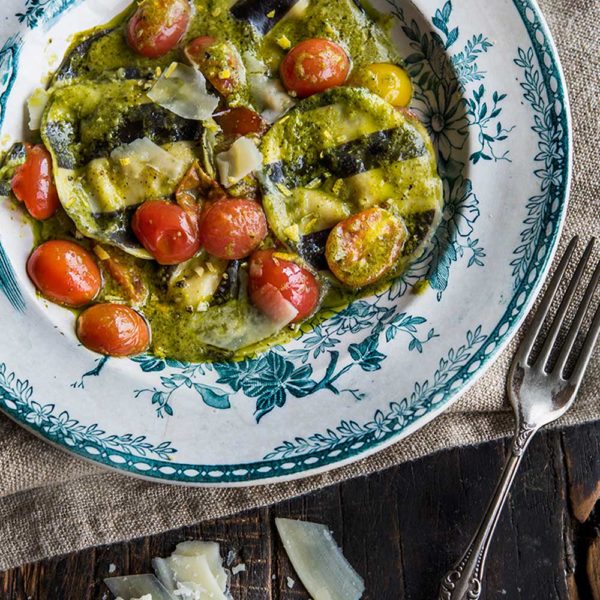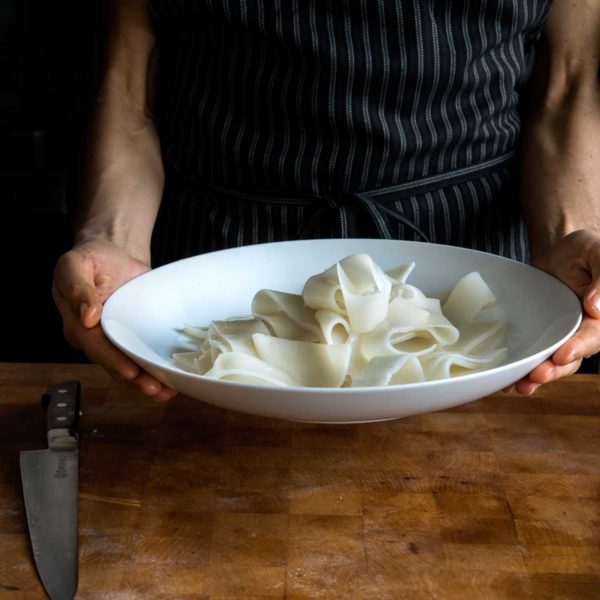If you’ve ever swam in the ocean and got your feet tangled up in a slimy plant growing on the sea floor, chances are you’ve encountered seaweed. If you’ve enjoyed sushi at your favorite Japanese restaurant, then you’ve mostly likely consumed seaweed.
The vast variety of ‘weeds’ that grow in the sea that we refer to as ‘seaweed’ are actually macroscopic (i.e., visible to the naked eye), multicellular, marine algae. Seaweed belongs to three broad groups of algae, encompassing more than 10,000 species: 1) red (e.g., nori, agar agar, dulse), 2) brown (e.g., kombu/kelp, wakame, arame, hijiki), and 3) green (e.g., sea lettuce, aonori). They grow in many types of seawaters from the ice-cold poles to the warm waters near the equator, as long as there is sufficient sunlight for photosynthesis.
There’s nothing new about seaweed. In fact, scientists estimate that it came into existence nearly 1.2 billion years ago. While seaweed has become ‘trendy’ in the United States in recent years, it’s been a staple in many diets around the world since ancient times from Asia, most notably Japan, China, and Korea, to Scotland, Ireland, Norway, Iceland, New Zealand, and the Pacific Islands.
Seaweed offers one of the broadest ranges of minerals of any food, containing virtually all the minerals found in the ocean (calcium, copper, iodine, iron, magnesium, manganese, molybdenum, phosphorus, potassium, selenium, vanadium, and zinc — to name a few). It’s also been touted for their anti-inflammatory, anti-cancer, anticoagulant, antithrombotic, and antiviral properties. One might even say seaweed is a ‘super food’ (but I don’t really like labels all that much).
Seaweed is not only beneficial to humans, but is good for oceans. It requires no fertilizing, weeding, or watering, and harbor few enemies in the form of pests or disease. In addition, seaweed is currently being investigated as a tool in water purification, to clean up polluted water systems.
Seaweed can be briny and salty. Its texture can range from rubbery to crispy and crunchy. It’s naturally high in glutamic acid, which is a flavoring agent most notably found in monosodium glutamate (MSG) and responsible for its umami taste. As for its uses, seaweed can be added to dressings, compound butter, spreads, soups, stews, salads, eggs, rice, noodles, and even desserts.
Let’s explore the different categories of seaweed…
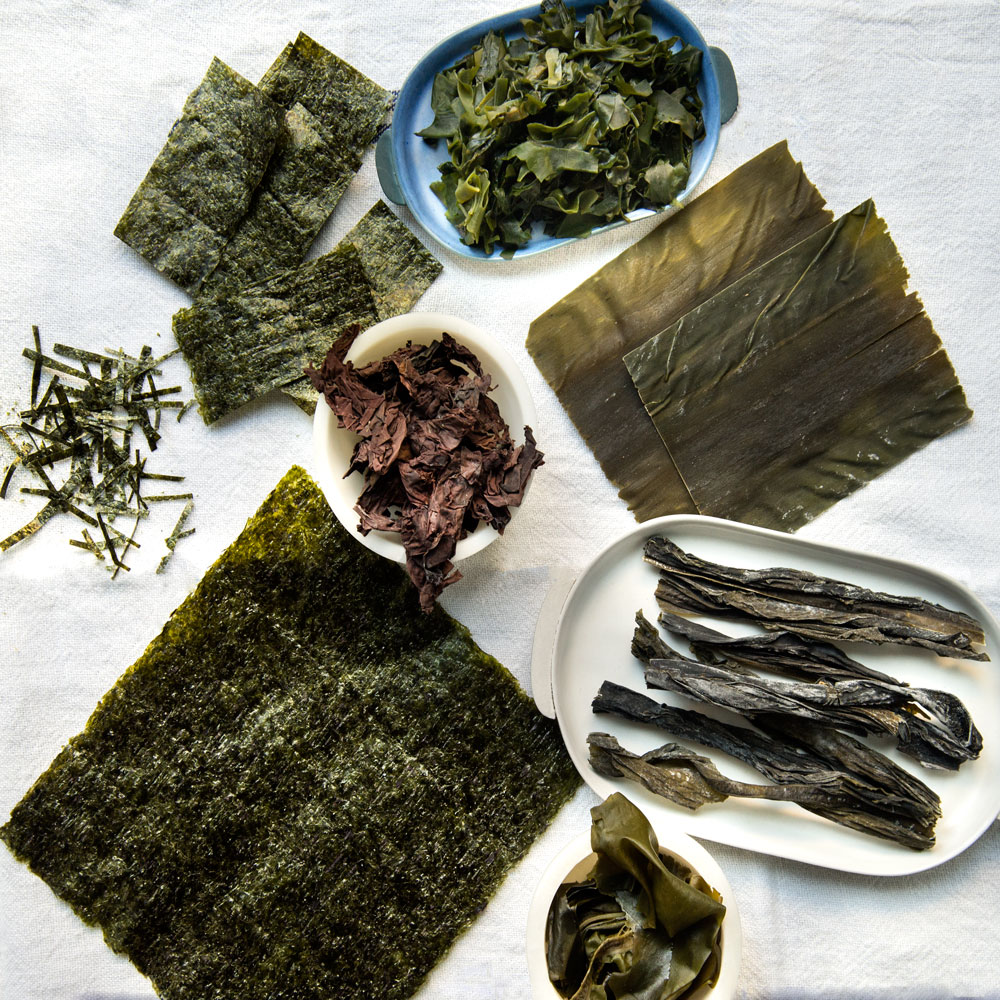
Red Algae: Nori, Agar, Dulse
You might be most familiar with nori, the purplish-black seaweed often found wrapped around rice in the form of sushi. Nori is made by shredding seaweed, pressing it into thin sheets, and rack drying. You can buy the sheets toasted or untoasted—or toast them yourself by holding a sheet over a flame of a gas burner for a few seconds until it turns a dark green color. In addition to sushi, nori is commonly used in onigiri (Japanese rice balls) and as a garnish for rice, soups, and stews.
Agar is another type of red algae and is widely used as a vegetarian gelatin substitute given its unique gelling properties. Dulse is a red algae that can be found in whole-leaf, flaked, or granule form, and even smoked (I recently purchased applewood smoked dulse at a local health-food store). Dulse is soft and chewy and doesn’t require any soaking or cooking. You can add it to salads, soups, or even omelets. When you pan-fry dulse in a little oil, it takes on a bacon-like flavor, especially the smoked variety (I was a bit skeptical at first, but it really does taste bacon-y).
Brown Algae: Kelp, Kombu, Wakame
Kombu is an essential ingredient in Korean and Japanese cooking. It’s one of the main ingredients in dashi, a classic Japanese stock, along with bonito flakes (katsuobushi in Japanese). Dashi is the foundation of many soups and stews, including the popular miso soup. You can also add a piece of kombu to a pot of simmering dried beans to enhance their flavor and digestibility. Wakame is a type of brown algae that comes from the cold waters off the coast of Japan, China, and Korea. It expands nearly tenfold and turns a dark greenish color when soaked. It’s an essential component of miso soup and often used in salads. I’ve even encountered wakame in a sea-vegetable sauerkraut that was quite tasty.
Green Algae: Sea Lettuce, Aonori
Sea lettuce is typically used in salads and soups. Aonori is typically dried and then made into a powder.
What does one do with seaweed?
In the past, I’ve used seaweed to make onigiri (Japanese stuffed rice balls), miso soup with mushrooms, smoked salmon handrolls, seaweed pasta (nori tagilatelle), to name a few. But I also happen to love a good salad.
This salad incorporates three different types of seaweed: wakame, applewood smoked dulse, and nori. Wakame, simply rehydrated and chopped; applewood-smoked dulse that I crisped up in a little oil, which adds a nice crunch and toastiness to the salad; and toasted nori in the form of furikake, a Japanese sesame-seed-based condiment. From there, add seasonal vegetables, avocado, rice/grains, etc. I like to add some spicy radish microgreens on top. All drizzled with a miso-ginger-soy dressing. Layer upon layer of umami.

SEAWEED SALAD with WAKAME, APPLEWOOD SMOKED DULSE, AND NORI
1 ounce dried wakame
1 ounce dried applewood-smoked dulse
Oil for pan-frying dulse
1 avocado, thinly sliced
1 carrot, thinly sliced with a vegetable peeler
1 blood orange, sectioned
1 seedless cucumber, thinly sliced
1 small bunch radish, cut into wedges
Miso-ginger-soy dressing (recipe below)
Handful of microgreens, such as radish, kale, or arugula
A couple tablespoons furikake (recipe below)
Place the wakame in a bowl and cover with water. Soak until soft, about 5 minutes. Squeeze dry. Chop into bite-sized pieces.
Coat the bottom of a skillet with a thin layer of oil. Heat the skillet over medium high heat. When the oil is hot, pan-fry pieces of dried dulse for 30 seconds to a minute, until the dulse gets crispy. Remove from the pan and set aside to cool.
Arrange wakame, avocado, carrot, cucumber, and radish in a bowl. Drizzle with miso-ginger-soy dressing. Top with microgreens. Sprinkle dulse and furikake on top.
MISO-GINGER-SOY DRESSING
2 tablespoons miso (used 1 tablespoon white and 1 tablespoon red)
2 tablespoons rice wine vinegar
1 tablespoon tamari or soy sauce
1 teaspoon ginger, grated
1 small clove garlic, grated
1½ teaspoons sesame oil
1 teaspoon mirin
Add all ingredients to a bowl, along with 2 tablespoons water. Whisk until well combined.
HOMEMADE FURIKAKE
In addition to sushi, one of my favorite uses for nori is in furikake, a savory Japanese seaweed condiment typically sprinkled over or mixed into rice. There are many commercially made furikake available for purchase, but it’s easy enough to make yourself. At a minimum all you need are nori, sesame seeds, bonito flakes (or katsuobushi, dried, paper-thin flakes of skipjack tuna), and salt. From there, you can add any number of extra ingredients. For instance, you can add spices, such as togarashi or cayenne; dried lemon or orange peel; dried fish, such as anchovies; or powdered miso. I like to add dried shiso leaves (an herb in the mint family that tastes like a cross between mint, cilantro, and basil) to the mix.
1/3 cup dried nori
1/3 cup toasted white sesame seeds
1/3 cup toasted black sesame seeds
1/3 cup bonito flakes, lightly packed
1 teaspoon togarashi (optional)
Sea salt to taste
Mix the nori, half of the white sesame seeds, half of the black sesame seeds, bonito flakes, and salt in a spice grinder. Pulse a few times until the mixture is the consistency of small flakes. Transfer to a small bowl and add in the rest of the white and black sesame seeds. Store in an airtight container at room temperature for several weeks (if it lasts that long).
